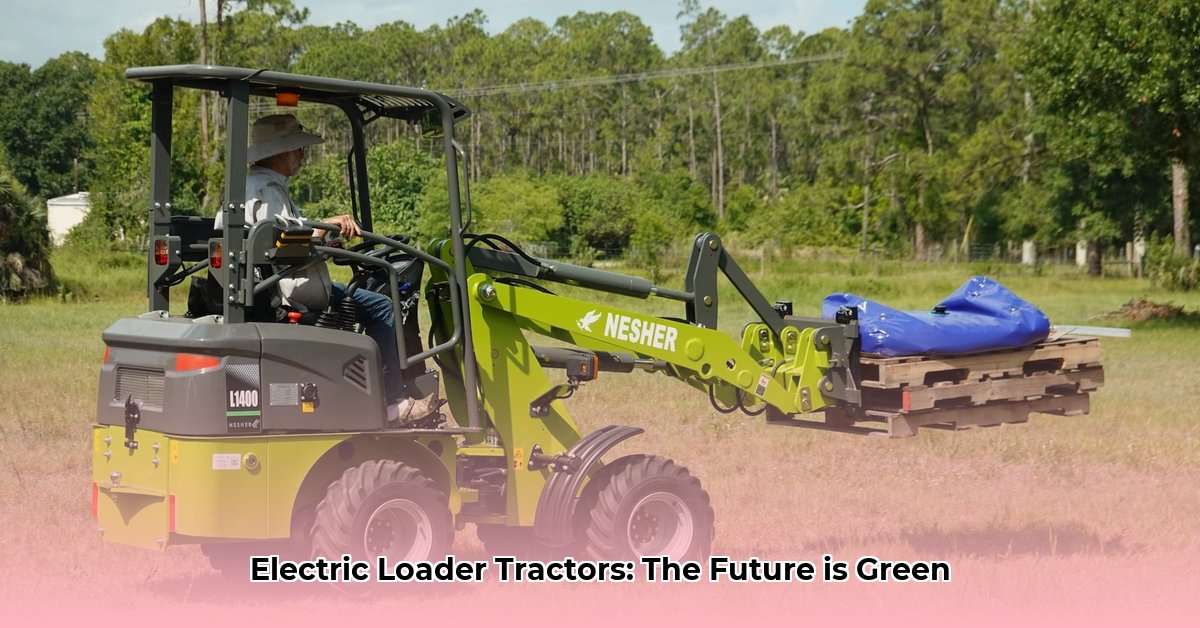
Electric Loader Tractors: Revolutionizing Construction's Green Future
The construction industry, traditionally reliant on noisy, polluting diesel equipment, is embracing a greener future with electric loader tractors. These machines offer a compelling blend of environmental responsibility and enhanced performance. However, the market presents a choice between differing technological approaches. This article compares two leading brands—Bobcat and MultiOne—analyzing their strategies and highlighting the advantages and disadvantages of each. For more information on small electric loaders, check out this helpful resource.
Bobcat: Power and Performance, Electrified
Bobcat, a prominent name in compact construction equipment, offers the all-electric T7X and S7X loader tractors. These machines are not simply electric versions of their gasoline counterparts; they're designed from the ground up to leverage electric power's advantages. Their focus is on pure electric performance, delivering substantial power via robust lithium-ion battery packs. However, the long-term lifespan of these batteries and their replacement costs are significant factors impacting total cost of ownership (TCO). Furthermore, sufficient charging infrastructure on construction sites is crucial for widespread adoption.
MultiOne: Adaptability and Versatility Take Center Stage
MultiOne's EZ series electric loader tractors prioritize versatility. Designed for diverse tasks in various settings, from large projects to smaller, confined spaces like indoor renovations, their compact size and maneuverability are key advantages. Unlike Bobcat's all-electric design, MultiOne utilizes electric motors with hydraulic systems. This difference leads to varying maintenance needs and likely different cost profiles.
A Head-to-Head Comparison: Bobcat vs. MultiOne
The following table summarizes the key differences:
| Feature | Bobcat T7X/S7X | MultiOne EZ Series |
|---|---|---|
| Powertrain | Purely electric; powerful lithium-ion batteries | Electric motor with a hydraulic system |
| Primary Focus | Maximum power and efficiency | Versatility and adaptability for various tasks |
| Ideal Jobs | Large-scale construction projects requiring power | Diverse tasks, including indoor and tight spaces |
| Hydraulic System | None; fully electric | Present |
| Maintenance | Potentially simpler, but battery replacement is key | More complex due to hydraulic components |
Is the higher upfront cost of electric loaders justified by long-term savings? A comprehensive TCO analysis is essential for determining the true value proposition.
The Road Ahead: Hurdles and Opportunities
Both manufacturers face common challenges. Battery technology continues to evolve—longer lifespans and higher energy density remain priorities. Standardized performance metrics are needed for fair comparisons. Robust service and parts networks are essential for field support. Finally, wider access to reliable charging infrastructure is a critical prerequisite for widespread adoption.
What Needs to Happen for Electric Loader Tractors to Succeed?
The success of electric loader tractors hinges on several key areas:
Manufacturers: Continued battery technology investment, development of standardized performance metrics, and robust service networks are essential. Transparency in publishing TCO data will build trust and encourage adoption.
Contractors/End-Users: Pilot programs are crucial for evaluating real-world performance and TCO. Thorough assessment of electric loader capabilities in relation to project needs and site conditions is vital. Exploration of financing options is also important.
Governments/Policymakers: Incentives like tax breaks and subsidies, investment in charging infrastructure, and clear safety standards will accelerate adoption.
Risk Factors: Considering the Uncertainties
The transition is not without risks:
| Risk Category | Likelihood | Impact | Potential Mitigation Strategies |
|---|---|---|---|
| Battery Failure/Degradation | Moderate | High | Advanced battery management systems, extended warranties, readily available replacements |
| Charging Infrastructure | Moderate | Moderate | Investment in on-site and public charging solutions, portable charging units |
| Market Acceptance | High | Moderate | Aggressive marketing campaigns, competitive pricing, flexible financing options |
| Regulatory Uncertainty | Low | Moderate | Proactive collaboration with regulatory agencies to establish clear standards |
How to Compare Total Cost of Ownership for Electric Compact Loaders
Understanding TCO is paramount when deciding between diesel and electric loaders. Beyond the initial purchase price, several factors influence long-term costs.
Initial Purchase Price: The First Hurdle
Electric loaders generally command a higher upfront price, largely due to battery costs.
Fuel and Energy Costs: A Shifting Landscape
While electricity prices can fluctuate, they are often more stable and predictable than diesel fuel costs, potentially leading to significant long-term savings.
Maintenance and Repair: Fewer Moving Parts, Lower Costs
Electric loaders typically have fewer moving parts, resulting in lower maintenance and repair expenses.
Battery Life and Replacement: A Long-Term Consideration
Battery lifespan and replacement costs significantly impact TCO. Warranty options and expected battery lifespans should be carefully considered.
Government Incentives and Tax Breaks: Boosting the Bottom Line
Government incentives can substantially reduce the upfront cost and improve return on investment.
A Simple TCO Comparison Table (Illustrative)
| Factor | Diesel Loader (Estimate) | Electric Loader (Estimate) | Notes |
|---|---|---|---|
| Initial Purchase Price | $50,000 | $65,000 | Varies greatly by model and features |
| Annual Fuel/Energy Costs | $5,000 | $1,500 | Based on average usage and energy prices |
| Annual Maintenance Costs | $3,000 | $1,000 | Fewer moving parts in electric loaders |
| Battery Replacement (5yr) | N/A | $20,000 | Significant cost; consider warranty periods |
| Government Incentives | $0 | $5,000 | Varies by location and program |
| Total 5-Year Cost | $63,000 | $76,000 | Considering all factors; these are estimates |
Note: These figures are estimates and will vary based on specific models, usage, and regional factors. Consult with equipment suppliers for precise details. The transition to electric construction equipment presents both opportunities and challenges. Thorough analysis of TCO, coupled with consideration of environmental factors, will guide informed decision-making. The future of construction is undoubtedly leaning towards sustainability, and electric loader tractors are at the forefront of this evolution.